Pic story of pilots providing service to foreign ships at Tianjin Port
Xinhua
1609685631000

Li Zhantao, a pilot of Tianjin Port Pilot Center, returns to the dock after a mission in north China's Tianjin, Dec. 28, 2020. Braving a temperature of minus 10 degrees Celsius, pilots climb up rope ladders of nearly 20 meters long to reach the deck of the ships they are expected to guide through waters in and around the Tianjin Port. The Chinese laws prescribe compulsory piloting for foreign ships entering or exiting ports in the country. Pilotage is also a practical need for foreign ships at the Tianjin port, which is noted for its busy and complicated shipping lanes. Pilots are subject to great occupational hazards, particularly when they have to reach the ship decks from helicopters or tugboats by rope ladders in bad weather. Enabling a ship of thousands of tons in capacity to dock with centimeter-grade precision is a challenge not only to a pilot's knowledge and experience but more to his or her physical limits. The 136-strong pilot team at the Tianjin Port, a world-level seafarin
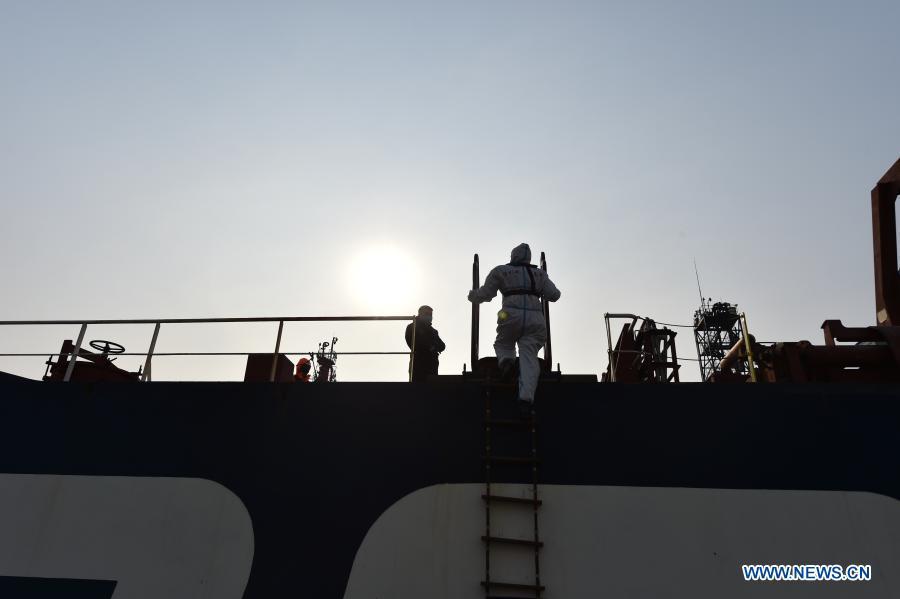
Li Zhantao, a pilot of Tianjin Port Pilot Center, is about to board a ship for piloting in north China's Tianjin, Dec. 28, 2020. Braving a temperature of minus 10 degrees Celsius, pilots climb up rope ladders of nearly 20 meters long to reach the deck of the ships they are expected to guide through waters in and around the Tianjin Port. The Chinese laws prescribe compulsory piloting for foreign ships entering or exiting ports in the country. Pilotage is also a practical need for foreign ships at the Tianjin port, which is noted for its busy and complicated shipping lanes. Pilots are subject to great occupational hazards, particularly when they have to reach the ship decks from helicopters or tugboats by rope ladders in bad weather. Enabling a ship of thousands of tons in capacity to dock with centimeter-grade precision is a challenge not only to a pilot's knowledge and experience but more to his or her physical limits. The 136-strong pilot team at the Tianjin Port, a world-level seafar

Li Zhantao, a pilot of Tianjin Port Pilot Center, directs a tugboat to help a ship depart from the dock in north China's Tianjin, Dec. 28, 2020. Braving a temperature of minus 10 degrees Celsius, pilots climb up rope ladders of nearly 20 meters long to reach the deck of the ships they are expected to guide through waters in and around the Tianjin Port. The Chinese laws prescribe compulsory piloting for foreign ships entering or exiting ports in the country. Pilotage is also a practical need for foreign ships at the Tianjin port, which is noted for its busy and complicated shipping lanes. Pilots are subject to great occupational hazards, particularly when they have to reach the ship decks from helicopters or tugboats by rope ladders in bad weather. Enabling a ship of thousands of tons in capacity to dock with centimeter-grade precision is a challenge not only to a pilot's knowledge and experience but more to his or her physical limits. The 136-strong pilot team at the Tianjin Port, a wo

Li Zhantao, a pilot of Tianjin Port Pilot Center, puts on a protective suit before boarding a ship for piloting in north China's Tianjin, Dec. 28, 2020. Braving a temperature of minus 10 degrees Celsius, pilots climb up rope ladders of nearly 20 meters long to reach the deck of the ships they are expected to guide through waters in and around the Tianjin Port. The Chinese laws prescribe compulsory piloting for foreign ships entering or exiting ports in the country. Pilotage is also a practical need for foreign ships at the Tianjin port, which is noted for its busy and complicated shipping lanes. Pilots are subject to great occupational hazards, particularly when they have to reach the ship decks from helicopters or tugboats by rope ladders in bad weather. Enabling a ship of thousands of tons in capacity to dock with centimeter-grade precision is a challenge not only to a pilot's knowledge and experience but more to his or her physical limits. The 136-strong pilot team at the Tianjin Po
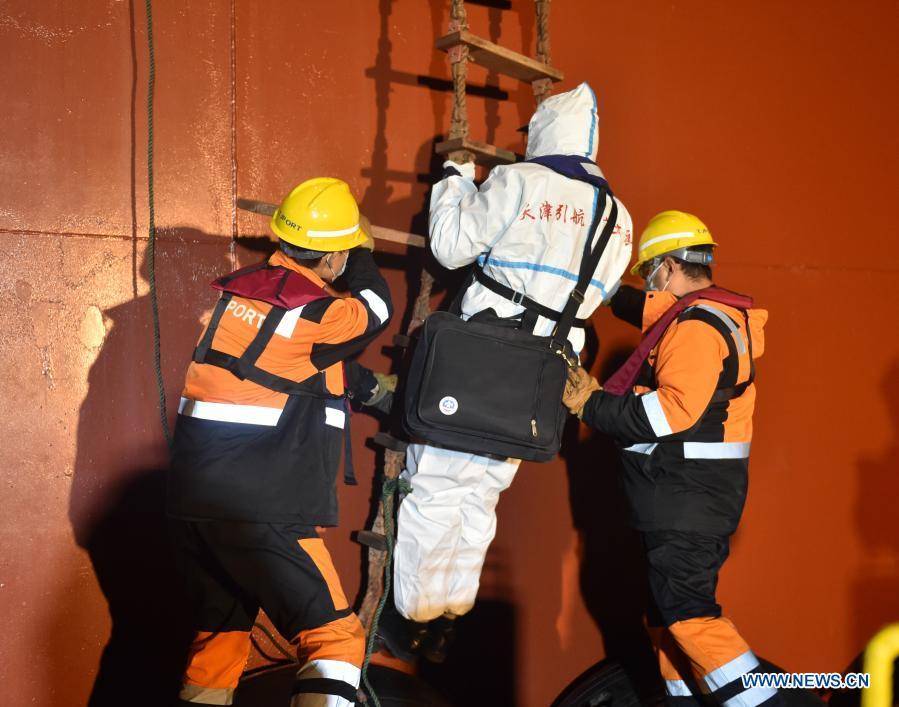
Yang Shengli, a pilot of Tianjin Port Pilot Center, climbs a rope ladder in protective suit in north China's Tianjin, Dec. 28, 2020. Braving a temperature of minus 10 degrees Celsius, pilots climb up rope ladders of nearly 20 meters long to reach the deck of the ships they are expected to guide through waters in and around the Tianjin Port. The Chinese laws prescribe compulsory piloting for foreign ships entering or exiting ports in the country. Pilotage is also a practical need for foreign ships at the Tianjin port, which is noted for its busy and complicated shipping lanes. Pilots are subject to great occupational hazards, particularly when they have to reach the ship decks from helicopters or tugboats by rope ladders in bad weather. Enabling a ship of thousands of tons in capacity to dock with centimeter-grade precision is a challenge not only to a pilot's knowledge and experience but more to his or her physical limits. The 136-strong pilot team at the Tianjin Port, a world-level se
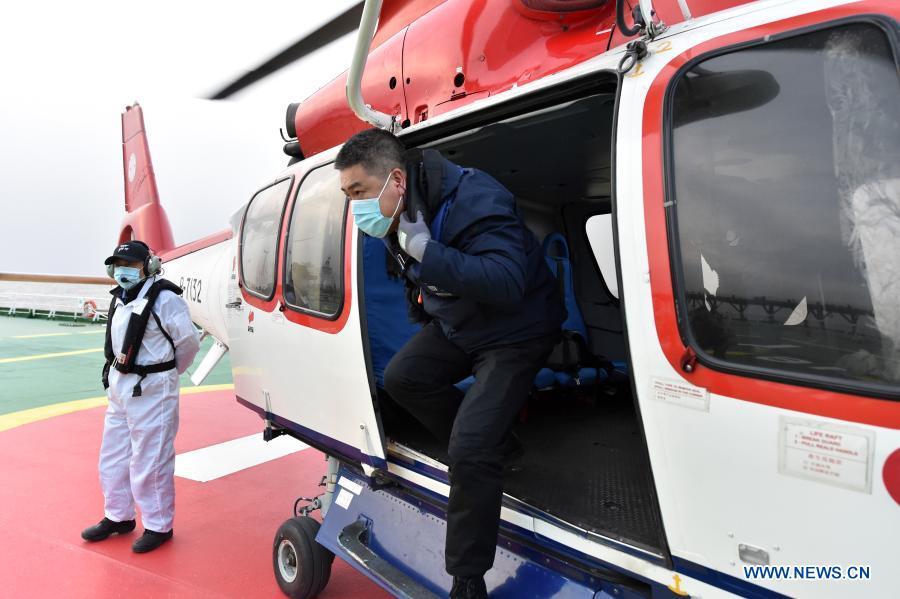
Liu Baoliang, a pilot of Tianjin Port Pilot Center, gets aboard a cargo ship for piloting from a helicopter in north China's Tianjin, Dec. 29, 2020. Braving a temperature of minus 10 degrees Celsius, pilots climb up rope ladders of nearly 20 meters long to reach the deck of the ships they are expected to guide through waters in and around the Tianjin Port. The Chinese laws prescribe compulsory piloting for foreign ships entering or exiting ports in the country. Pilotage is also a practical need for foreign ships at the Tianjin port, which is noted for its busy and complicated shipping lanes. Pilots are subject to great occupational hazards, particularly when they have to reach the ship decks from helicopters or tugboats by rope ladders in bad weather. Enabling a ship of thousands of tons in capacity to dock with centimeter-grade precision is a challenge not only to a pilot's knowledge and experience but more to his or her physical limits. The 136-strong pilot team at the Tianjin Port,
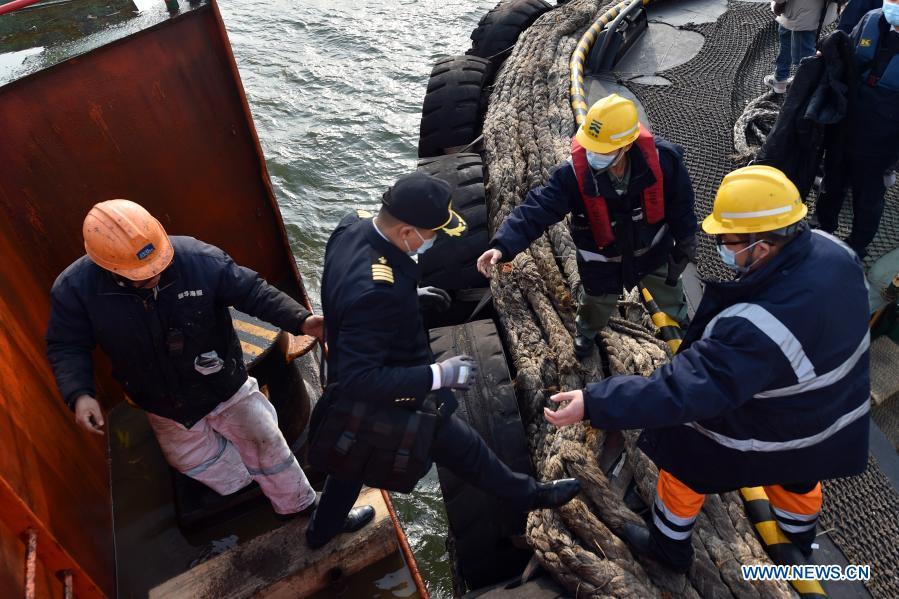
Li Zhantao, a pilot of Tianjin Port Pilot Center, returns to a tugboat after a mission in north China's Tianjin, Dec. 28, 2020. Braving a temperature of minus 10 degrees Celsius, pilots climb up rope ladders of nearly 20 meters long to reach the deck of the ships they are expected to guide through waters in and around the Tianjin Port. The Chinese laws prescribe compulsory piloting for foreign ships entering or exiting ports in the country. Pilotage is also a practical need for foreign ships at the Tianjin port, which is noted for its busy and complicated shipping lanes. Pilots are subject to great occupational hazards, particularly when they have to reach the ship decks from helicopters or tugboats by rope ladders in bad weather. Enabling a ship of thousands of tons in capacity to dock with centimeter-grade precision is a challenge not only to a pilot's knowledge and experience but more to his or her physical limits. The 136-strong pilot team at the Tianjin Port, a world-level seafari

Yang Shengli, a pilot of Tianjin Port Pilot Center, prepares to get aboard a ship by rope ladder from a tugboat in north China's Tianjin, Dec. 28, 2020. Braving a temperature of minus 10 degrees Celsius, pilots climb up rope ladders of nearly 20 meters long to reach the deck of the ships they are expected to guide through waters in and around the Tianjin Port. The Chinese laws prescribe compulsory piloting for foreign ships entering or exiting ports in the country. Pilotage is also a practical need for foreign ships at the Tianjin port, which is noted for its busy and complicated shipping lanes. Pilots are subject to great occupational hazards, particularly when they have to reach the ship decks from helicopters or tugboats by rope ladders in bad weather. Enabling a ship of thousands of tons in capacity to dock with centimeter-grade precision is a challenge not only to a pilot's knowledge and experience but more to his or her physical limits. The 136-strong pilot team at the Tianjin Po

Li Ye, a pilot of Tianjin Port Pilot Center, watches closely over other ships and tugboats aboard a departing ship in north China's Tianjin, Dec. 28, 2020. Braving a temperature of minus 10 degrees Celsius, pilots climb up rope ladders of nearly 20 meters long to reach the deck of the ships they are expected to guide through waters in and around the Tianjin Port. The Chinese laws prescribe compulsory piloting for foreign ships entering or exiting ports in the country. Pilotage is also a practical need for foreign ships at the Tianjin port, which is noted for its busy and complicated shipping lanes. Pilots are subject to great occupational hazards, particularly when they have to reach the ship decks from helicopters or tugboats by rope ladders in bad weather. Enabling a ship of thousands of tons in capacity to dock with centimeter-grade precision is a challenge not only to a pilot's knowledge and experience but more to his or her physical limits. The 136-strong pilot team at the Tianjin
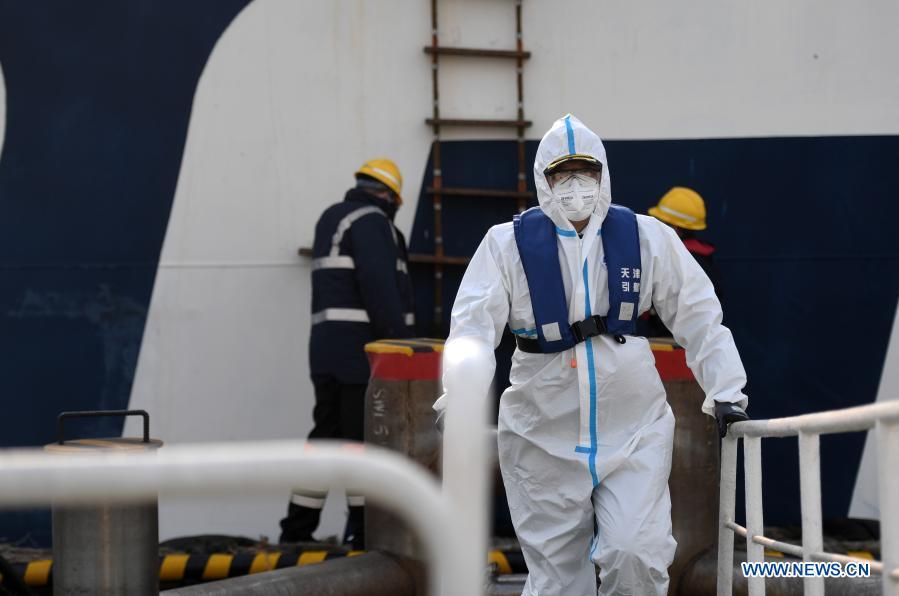
Li Zhantao, a pilot of Tianjin Port Pilot Center, returns to a tugboat after a mission in north China's Tianjin, Dec. 28, 2020. Braving a temperature of minus 10 degrees Celsius, pilots climb up rope ladders of nearly 20 meters long to reach the deck of the ships they are expected to guide through waters in and around the Tianjin Port. The Chinese laws prescribe compulsory piloting for foreign ships entering or exiting ports in the country. Pilotage is also a practical need for foreign ships at the Tianjin port, which is noted for its busy and complicated shipping lanes. Pilots are subject to great occupational hazards, particularly when they have to reach the ship decks from helicopters or tugboats by rope ladders in bad weather. Enabling a ship of thousands of tons in capacity to dock with centimeter-grade precision is a challenge not only to a pilot's knowledge and experience but more to his or her physical limits. The 136-strong pilot team at the Tianjin Port, a world-level seafari
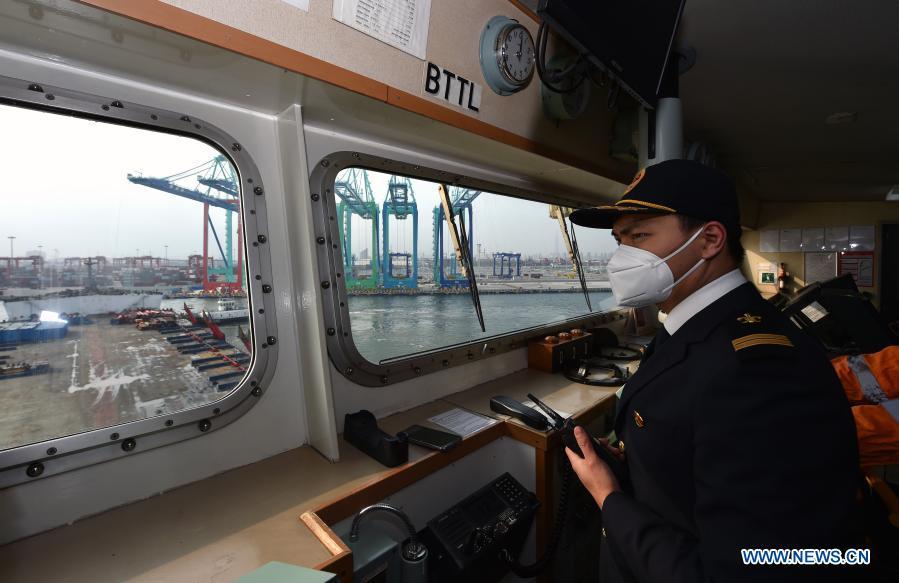
Li Ye, a pilot of Tianjin Port Pilot Center, watches closely over other ships and tugboats aboard a departing ship in north China's Tianjin, Dec. 28, 2020. Braving a temperature of minus 10 degrees Celsius, pilots climb up rope ladders of nearly 20 meters long to reach the deck of the ships they are expected to guide through waters in and around the Tianjin Port. The Chinese laws prescribe compulsory piloting for foreign ships entering or exiting ports in the country. Pilotage is also a practical need for foreign ships at the Tianjin port, which is noted for its busy and complicated shipping lanes. Pilots are subject to great occupational hazards, particularly when they have to reach the ship decks from helicopters or tugboats by rope ladders in bad weather. Enabling a ship of thousands of tons in capacity to dock with centimeter-grade precision is a challenge not only to a pilot's knowledge and experience but more to his or her physical limits. The 136-strong pilot team at the Tianjin

Li Zhantao, a pilot of Tianjin Port Pilot Center, climbs a rope ladder in protective suit in north China's Tianjin, Dec. 28, 2020. Braving a temperature of minus 10 degrees Celsius, pilots climb up rope ladders of nearly 20 meters long to reach the deck of the ships they are expected to guide through waters in and around the Tianjin Port. The Chinese laws prescribe compulsory piloting for foreign ships entering or exiting ports in the country. Pilotage is also a practical need for foreign ships at the Tianjin port, which is noted for its busy and complicated shipping lanes. Pilots are subject to great occupational hazards, particularly when they have to reach the ship decks from helicopters or tugboats by rope ladders in bad weather. Enabling a ship of thousands of tons in capacity to dock with centimeter-grade precision is a challenge not only to a pilot's knowledge and experience but more to his or her physical limits. The 136-strong pilot team at the Tianjin Port, a world-level seaf


